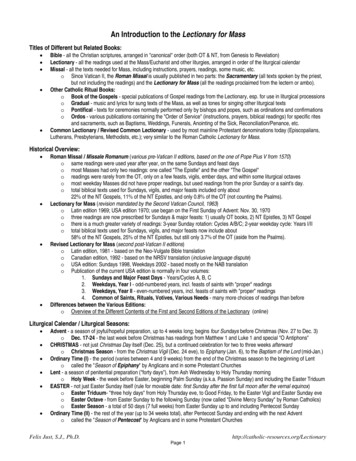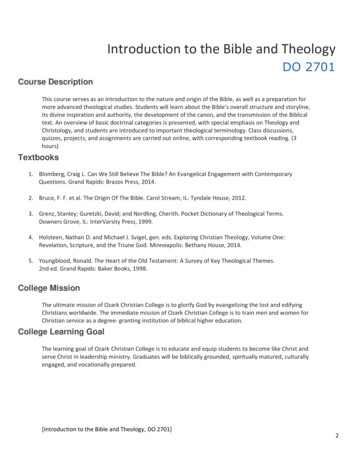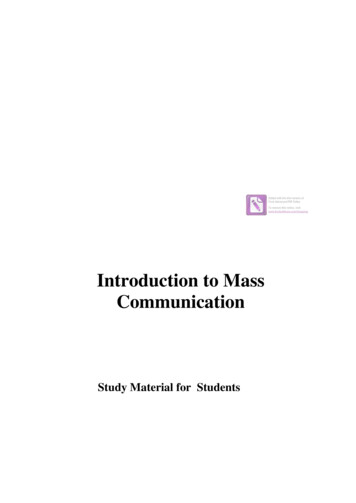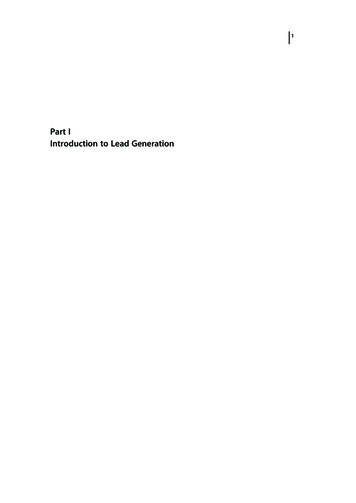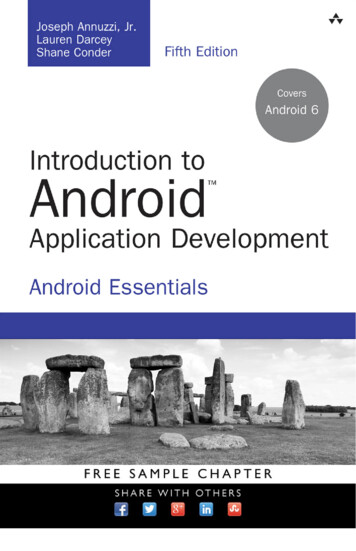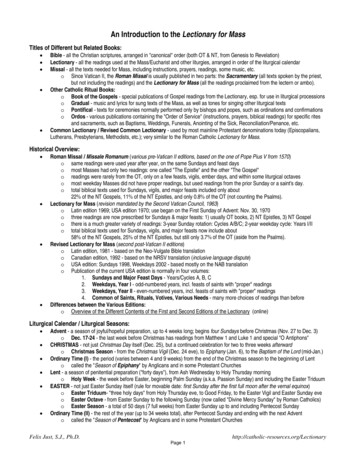
Transcription
An Introduction to the Lectionary for MassTitles of Different but Related Books: Bible - all the Christian scriptures, arranged in "canonical" order (both OT & NT, from Genesis to Revelation)Lectionary - all the readings used at the Mass/Eucharist and other liturgies, arranged in order of the liturgical calendarMissal - all the texts needed for Mass, including instructions, prayers, readings, some music, etc.o Since Vatican II, the Roman Missal is usually published in two parts: the Sacramentary (all texts spoken by the priest,but not including the readings) and the Lectionary for Mass (all the readings proclaimed from the lectern or ambo).Other Catholic Ritual Books:o Book of the Gospels - special publications of Gospel readings from the Lectionary, esp. for use in liturgical processionso Gradual - music and lyrics for sung texts of the Mass, as well as tones for singing other liturgical textso Pontifical - texts for ceremonies normally performed only by bishops and popes, such as ordinations and confirmationso Ordos - various publications containing the "Order of Service" (instructions, prayers, biblical readings) for specific ritesand sacraments, such as Baptisms, Weddings, Funerals, Anointing of the Sick, Reconciliation/Penance, etc.Common Lectionary / Revised Common Lectionary - used by most mainline Protestant denominations today (Episcopalians,Lutherans, Presbyterians, Methodists, etc.); very similar to the Roman Catholic Lectionary for Mass.Historical Overview: Roman Missal / Missale Romanum (various pre-Vatican II editions, based on the one of Pope Pius V from 1570)o same readings were used year after year, on the same Sundays and feast dayso most Masses had only two readings: one called "The Epistle" and the other "The Gospel"o readings were rarely from the OT, only on a few feasts, vigils, ember days, and within some liturgical octaveso most weekday Masses did not have proper readings, but used readings from the prior Sunday or a saint's day.o total biblical texts used for Sundays, vigils, and major feasts included only about22% of the NT Gospels, 11% of the NT Epistles, and only 0.8% of the OT (not counting the Psalms).Lectionary for Mass (revision mandated by the Second Vatican Council, 1963)o Latin edition 1969; USA edition 1970; use began on the First Sunday of Advent: Nov. 30, 1970o three readings are now prescribed for Sundays & major feasts: 1) usually OT books, 2) NT Epistles, 3) NT Gospelo there is a much greater variety of readings: 3-year Sunday rotation: Cycles A/B/C; 2-year weekday cycle: Years I/IIo total biblical texts used for Sundays, vigils, and major feasts now include about58% of the NT Gospels, 25% of the NT Epistles, but still only 3.7% of the OT (aside from the Psalms).Revised Lectionary for Mass (second post-Vatican II editions)o Latin edition, 1981 - based on the Neo-Vulgate Bible translationo Canadian edition, 1992 - based on the NRSV translation (inclusive language dispute)o USA edition: Sundays 1998, Weekdays 2002 - based mostly on the NAB translationo Publication of the current USA edition is normally in four volumes:1. Sundays and Major Feast Days - Years/Cycles A, B, C2. Weekdays, Year I - odd-numbered years, incl. feasts of saints with "proper" readings3. Weekdays, Year II - even-numbered years, incl. feasts of saints with "proper" readings4. Common of Saints, Rituals, Votives, Various Needs - many more choices of readings than beforeDifferences between the Various Editions:o Overview of the Different Contents of the First and Second Editions of the Lectionary (online)Liturgical Calendar / Liturgical Seasons: Advent - a season of joyful/hopeful preparation, up to 4 weeks long; begins four Sundays before Christmas (Nov. 27 to Dec. 3)o Dec. 17-24 - the last week before Christmas has readings from Matthew 1 and Luke 1 and special "O Antiphons"CHRISTMAS - not just Christmas Day itself (Dec. 25), but a continued celebration for two to three weeks afterwardo Christmas Season - from the Christmas Vigil (Dec. 24 eve), to Epiphany (Jan. 6), to the Baptism of the Lord (mid-Jan.)Ordinary Time (I) - the period (varies between 4 and 9 weeks) from the end of the Christmas season to the beginning of Lento called the "Season of Epiphany" by Anglicans and in some Protestant ChurchesLent - a season of penitential preparation ("forty days"), from Ash Wednesday to Holy Thursday morningo Holy Week - the week before Easter, beginning Palm Sunday (a.k.a. Passion Sunday) and including the Easter TriduumEASTER - not just Easter Sunday itself (rule for movable date: first Sunday after the first full moon after the vernal equinox)o Easter Triduum- "three holy days" from Holy Thursday eve, to Good Friday, to the Easter Vigil and Easter Sunday eveo Easter Octave - from Easter Sunday to the following Sunday (now called "Divine Mercy Sunday" by Roman Catholics)o Easter Season - a total of 50 days (7 full weeks) from Easter Sunday up to and including Pentecost SundayOrdinary Time (II) - the rest of the year (up to 34 weeks total), after Pentecost Sunday and ending with the next Advento called the "Season of Pentecost" by Anglicans and in some Protestant ChurchesFelix Just, S.J., Ph.D.Page 1http://catholic-resources.org/Lectionary
Liturgical Colors: Advent - Purple, except for Rose (optional) on the 3rd Sunday of Advent ("Gaudete Sunday")Christmas - White or Gold (not red and green!)Lent - Purple, except Rose (optional) on the 4th Sunday of Lent ("Laetare Sunday"), and Red on Passion/Palm SundayEaster Triduum - White or Gold on Holy Thursday and at the Easter Vigil; Red on Good FridayEaster Season - White or Gold, except for Red on Pentecost SundayOrdinary Time - Green, except for special colors on particular feasts or occasions, as follows:o White - Solemnities of the Lord and the Saints; major local feasts; funeral liturgies (Black also allowed)o Red - feasts of the Apostles, Martyrs, or the Holy SpiritMasses for Sundays and Major Feast Days: Three Readings - really five!1.2.3.4.5.First Reading - from the Old Testament; except from Acts of the Apostles during Easter SeasonResponsorial Psalm - mostly from the Book of Psalms; sometimes other biblical "Canticles"Second Reading - mostly from the Letters of Paul, but sometimes other NT Epistles and the Book of RevelationVerse before the Gospel - usually a direct biblical quotation, but sometimes adapted from a biblical textGospel - Year A: Matthew; Year B: Mark mostly; Year C: Luke; (where's John? used mostly in Lent & Easter)Masses for Weekdays, Lesser Feasts, and Special Occasions: Two Readings - really four!1.2.3.4.First Reading - semi-continuous readings; alternate between OT & NT; on a two-year cycleResponsorial Psalm - mostly from the Book of Psalms, but sometimes other Canticles; also on a two-year cycleVerse before the Gospel - first edition had mostly "common" texts; now specifically prescribed textsGospel - same each year; semi-continuous readings from Mark, Matthew, Luke, in that orderReadings for Special Masses and Liturgies: Saints - four categories, in decreasing order of importance: Solemnities, Feasts, Memorials, Optional Memorialso some saints have their own "Propers" - prayers and readings specifically selected for the particular sainto for other feast days, texts and prayers are recommended from various "Commons" - Anniversary of the Dedication of aChurch, Blessed Virgin Mary, Martyrs, Pastors, Doctors of the Church, Virgins, and Holy Men & WomenRitual Masses - incl. Christian Initiation (of adults or children; baptism, confirmation, and first communion), Conferral of HolyOrders and other Ministries, Pastoral Care of the Sick and Dying, Sacrament of Marriage, Religious Profession, Blessing of aChurch or Altar, etc.Masses for Various Occasions - four subcategories:o for the Holy Church (incl. pope, pastoral meetings, unity of Christians, etc.),o for Public Needs (civil leaders, peace and justice, in time of war, etc.),o in Various Public Circumstances (new year, harvest, refugees, natural disasters, etc.),o and for Various Needs (promotion of charity, for the family, for a happy death, etc.)Votive Masses - Holy Trinity, Holy Cross, Holy Eucharist, Christ the High Priest, Holy Name of Jesus, Precious Blood, SacredHeart, Blessed Virgin Mary, St. Joseph, All the Holy Apostles, Sts. Peter & Paul, St. Peter, St. Paul, One Holy Apostle, All SaintsMasses for the Dead - incl. Funeral Liturgies and Memorial Masses, Funerals for Baptized Children, and Funerals for Childrenwho Died before BaptismConcluding Notes: On most Sundays, there is an intentional thematic connection between the Gospel & the First Reading (usually also the Resp.Psalm & Gospel Accl.); but the Second Reading is usually unrelated, since it follows a separate semi-continuous reading pattern.If one includes all the Masses for weekdays, rituals, votives, the propers and commons of saints, and special needs and occasions,the Lectionary for Mass now covers much of the NT (about 90% of the Gospels, 55% of the rest: Acts, Epistles, Revelation), butstill very little of the OT (slightly over 13%), but this is understandable, given how much longer the OT is.For more information, see http://catholic-resources.org/Lectionary/Felix Just, S.J., Ph.D.Page 2http://catholic-resources.org/Lectionary
General Introduction to the Lectionary (Second Edition)Sacred Congregation for the Sacraments and Divine Worship (January 21, 1981)PreambleChapter I: General Principles for the Liturgical Celebration of the Word of God1. Certain Preliminaries2. Liturgical Celebration of the Word of God3. The Word of God in the Life of the People of the CovenantFirst Part: The Word of God in the Celebration of MassChapter II: The Celebration of the Liturgy of the Word at Mass1. The Elements of the Liturgy of the Word and Their Rites2. Aids to the Proper Celebration of the Liturgy of the WordChapter III: Offices and Ministries in the Celebration of the Liturgy of the Word within Mass1. The Function of the President at the Liturgy of the Word2. The Role of the Faithful in the Liturgy of the Word3. Ministries in the Liturgy of the WordSecond Part: The Structure of the Order of Readings for MassChapter IV: The General Arrangement of Readings for Mass1. The Pastoral Purpose of the Order of Readings for Mass2. The Principles of Composition of the Order of Readings for Mass3. Principles to Be Followed in the Use of the Order of ReadingChapter V: Description of the Order of Readings1. Advent2. The Christmas Season3. Lent4. The Sacred Triduum and the Easter Season5. “Ordinary Time”Chapter VI: Adaptations, Translations, and Format of the Order of Readings1. Adaptations and Translations2. The Format of Individual ReadingsEndnotesFelix Just, S.J., Ph.D.Page 3http://catholic-resources.org/Lectionary/
Various Editions of the Roman Catholic Lectionary for MassOverview and Abbreviations, in chronological order of publication: OLM69 Ordo Lectionum Missae, editio typica. Vatican City: Typis Polyglottis Vaticanis, 1969. USCC69 Lectionary for Mass. Washington, DC: United States Catholic Conference, 1969. USCC70 Lectionary for Mass: List of Readings and Charts for the Liturgy of the Word. Washington, DC: United StatesCatholic Conference, 1969; 2nd edition 1970. USL70 Lectionary for Mass: English Translation Approved by the National Conference of Catholic Bishops andConfirmed by the Apostolic See. New York: Catholic Book Publishing, 1970; Collegeville, MN: Liturgical Press, 1970. OLM81 Ordo Lectionum Missae, editio typica altera. Vatican City: Typis Polyglottis Vaticanis, 1981. USL98 Lectionary for Mass: For Use in the Dioceses of the United States of America: Second Typical Edition. [variouspublishers], 1998. – Volume I (Sundays, Solemnities, Feasts of the Lord and the Saints). USL02 Lectionary for Mass: For Use in the Dioceses of the United States of America: Second Typical Edition. [variouspublishers], 2002. – Volumes II-IV:o Volume II: Proper of Seasons for Weekdays, Year I; Proper of Saints; Common of Saints;o Volume III: Proper of Seasons for Weekdays, Year II; Proper of Saints; Common of Saints;o Volume IV: Common of Saints; Ritual Masses; Masses for Various Needs; Votive Masses; and Masses for the Dead. USL98-02 an abbreviation sometimes used to refer to all four of the above volumes together.Further Explanations:The Latin Ordos (OLM69 and OLM81) do not contain the full biblical texts of all the readings, but only print the biblical references,a brief phrase to be used as a header, and the incipit (the opening words) for each reading. They also explicitly print theprescribed texts for the Psalm Responses and the Alleluia Verses (or "Verses before the Gospel" during Lent). The USCCpublications have most of this information in English translation, but they unfortunately do not include the incipits. The fullLectionaries published for use in the United States (USL70 and USL98) contain the biblical texts of all the readings.OLM69 was officially promulgated by the Vatican "Congregation for Divine Worship" on May 25, 1969. It prescribes all thereadings for all Masses celebrated throughout the liturgical year: Sundays, Weekdays, Saints Days, Rituals, Votives, SpecialNeeds and Occasions, etc. It includes the full text (in Latin) for the Psalm Responses and Alleluia Verses, but for the FirstReadings, Second Readings, and Gospels, it includes only the biblical references, a summary phrase, and the incipit (first words)of each reading, but not the complete text. For the Responsorial Psalms, it clearly indicates which verses are to be included inwhich strophe. All biblical references are given according to the Vulgate edition of the Bible, with parenthetical remarks if theversification of the Hebrew or Greek Bibles is different from the Vulgate. Nevertheless, there is sometimes ambiguity about exactlywhere a reading should end, or which words or phrases are to be included, due to minor variations in the wording and versificationof the Bible in the various ancient languages and modern editions.USCC69 and USCC70 are essentially English-language equivalents of OLM69, with translations of the Psalm Responses, AlleluiaVerses, and Summary Phrases prepared and copyrighted by the International Committee on English in the Liturgy. Like OLM69,they do not contain the full texts of the readings, but were intended as guides for publishers preparing complete Lectionaries usingvarious English translations of the Bible. The first edition was published by the USCC in 1969 and a second edition in 1970, "withrevisions indicated by Congregation for Divine Worship 7/24/70." This evidently refers to the "Instruction on ParticularCalendars ," which was promulgated not on July 24, but on June 24, 1970 (see Acta Apostolicae Sedis 62 [1970] 651-663).USL70 contains the full text of all readings, "with the New American Version of sacred scripture from the original languages madeby members of the Catholic Biblical Association and sponsored by the Bishop’s Committee of the Division of Religious Education(Confraternity of Christian Doctrine," or what is more commonly known as the New American Bible (NAB). The Catholic BookPublishing Company (CBP) was not the only publisher that immediately produced a complete edition of the Lectionary for use inthe United States (Benzinger in New York did so using the Jerusalem Bible translation). But the CBP edition is probably the onemost widely used in parishes throughout the USA, and thus was the one used in compiling the following charts.OLM81 is the official second edition of the "Order of Readings for Mass" in Latin, promulgated on January 21, 1981. It correctedmost of the typographical errors of the OLM69, as noted below, but also incorporated many other changes and additions to theLectionary. OLM81 and the revised Lectionaries based upon it are sometimes referred to as "second generation" liturgical texts.USL98 and USL02 were published rather long after OLM81, and four years apart, due to many delays in the preparations andapprovals needed for the English language editions for use in the United States. USL98-02 follows most of the prescriptions ofOLM81, with only a few discrepancies.Felix Just, S.J., Ph.D.Page 4http://catholic-resources.org/Lectionary/
Calendar of Lectionary Cycles and Movable Liturgical Feasts (1969 – 2050)NOTE: In 2008 and 2011, Easter Sunday was almost as early and almost as late as possible, respectively.It can be as early as March 22 (as it last was in 1818, but will not be again until 2285) and as late as April 25 (in 1886, 1943, and 2038).Even falling as early as March 23 is rare (as it was in 1913 and 2008, but will not be again until 20432044204520462047204820492050Sunday Weekday Weeks of O.T.AshEaster Pentecost Week of O.T. First SundayCycleCyclebefore Lent* Wednesday Sunday Sunday after Pentecost* of AdventAII4Feb 6March 23 May 116Nov 30BI7Feb 25April 12May 319Nov 29CII6Feb 17April 4May 238Nov 28AI9March 9April 24 June 1211Nov 27BII7Feb 22April 8May 278Dec 2CI5Feb 13March 31 May 197Dec 1AII8March 5April 20June 810Nov 30BI6Feb 18April 5May 248Nov 29CII5Feb 10March 27 May 157Nov 27AI8March 1April 16June 49Dec 3BII6Feb 14April 1May 207Dec 2CI8March 6April 21June 910Dec 1AII7Feb 26April 12May 319Nov 29BI6Feb 27April 4May 238Nov 28CII8March 2April 17June 510Nov 27AI7Feb 22April 9May 288Dec 3BII6Feb 14March 31 May 197Dec 1CI8March 5April 20June 810Nov 30AII6Feb 18April 5May 248Nov 29BI5Feb 10March 28 May 167Nov 28CII8March 1April 16June 49Dec 3AI6Feb 14April 1May 207Dec 2BII8March 6April 21June 910Dec 1CI7Feb 26April 13June 19Nov 30AII5Feb 11March 28 May 167Nov 28BI8March 2April 17June 510Nov 27CII7Feb 22April 9May 288Dec 3AI5Feb 7March 25 May 136Dec 2BII7Feb 27April 13June 19Nov 30CI6Feb 18April 5May 248Nov 29AII9March 10April 25 June 1311Nov 28BI7Feb 23April 10May 299Nov 27CII6Feb 15April 1May 207Dec 2AI8March 6April 21June 910Dec 1BII6Feb 19April 6May 258Nov 30CI5Feb 11March 29 May 177Nov 29AII8March 2April 17June 510Nov 27BI7Feb 22April 9May 288Dec 3CII5Feb 7March 25 May 136Dec 2AI7Feb 29April 14June 29Dec 1BII6Feb 19April 5May 248Nov 29CI8Mar 3April 18June 610Nov 28AII7Feb 23April 10May 299Nov sdayFridaySaturdaySunday* Note: Since the length of the Advent Season varies (between three and four weeks, depending on which weekday Christmas falls), but in order toensure that the readings for the 34th Week in Ordinary Time are read at the very end of each liturgical year, one entire week of Ordinary Time is often(but not always) omitted after the Season of Easter. Thus, for example, if the weekdays just before Lent belong to the 5th week of O.T., then afterPentecost we continue with the 6th week of O.T. in some years, but skip to the 7th week of O.T. in most years.Page 5
Liturgical Introductions for Scripture ReadingsA reading from the Book of Genesis (or Exodus, Joshua, Proverbs, Job, etc., for most OT books).A reading from the first (or second) Book of Samuel (or Kings, Chronicles, Maccabees).A reading from the Book of the prophet Isaiah (or Jeremiah, Ezekiel, Hosea, etc., for all prophets).A reading from the Song of Songs. (the only OT text not “from the Book of ”)A reading from the Acts of the Apostles.A reading from the Letter of Paul to the Romans (or Galatians, Ephesians, Philippians, Colossians).A reading from the first (or second) Letter of Paul to the Corinthians (or Thessalonians).A reading from the first (or second) Letter of Paul to Timothy.A reading from the Letter of Paul to Titus (or Philemon).A reading from the Letter TO the Hebrews. (not “ of Paul to the Hebrews”)A reading from the Letter OF James (or Jude).A reading from the first (or second, or third) Letter of Peter (or John).A reading from the Book of Revelation. (not plural “Revelations”)A reading from the holy Gospel according to Matthew (or Mark, Luke, John).Conclusions for Liturgical Readings:After the 1st and 2nd readings: “The Word of the Lord” (not “This is the Word ”)After the Gospel readings: “The Gospel of the Lord” or “The Good News of Our Salvation”Alternate Introductions for Scripture Readings: (with “Saint”)A reading from the Letter of Saint Paul to the Romans (or Galatians, Ephesians, Philippians, Colossians).A reading from the first (or second) Letter of Saint Paul to the Corinthians (or Thessalonians).A reading from the first (or second) Letter of Saint Paul to Timothy.A reading from the Letter of Saint Paul to Titus (or Philemon).A reading from the Letter of Saint James (or Jude).*A reading from the first (or second, or third) Letter of Saint Peter (or John).A reading from the holy Gospel according to Saint Matthew (or Mark, Luke, John).**Note: The Lectionary for Mass (1998/2002) is inconsistent with the use of the title “Saint” before names. The title “Saint” is explicitly added before the names of most of the Apostles (Paul, Peter, John, Jude), butcuriously not before the names of the four Evangelists. The Spanish translation of the Roman Missal has“San Mateo,” “San Marcus,” etc. The usage is inconsistent for James: Readings 695.1, 716.7, 740.13, and 792.13 have “Saint James,” butreadings 883.9, 883.10, 888.3, 898.3, 903.2, 923.2, 934.4, and 939.3 (all in the section of “Masses forVarious Needs and Occasions”) merely say “A reading from the Letter of James.” Although Paul is called “Saint,” Timothy and Titus are not; the Lectionary says, “A reading of the firstLetter of St. Paul to Timothy,” rather than “ Saint Paul to Saint Timothy” (or Titus).Felix Just, S.J., Ph.D.http://catholic-resources.org/LectionaryPage 6
Lectionary Readings for Sundays and Major Feasts in the Special Liturgical 37-C38-CSunday or Feast1st Sunday of Advent2nd Sunday of Advent3rd Sunday of Advent4th Sunday of Advent1st Sunday of Advent2nd Sunday of Advent3rd Sunday of Advent4th Sunday of Advent1st Sunday of Advent2nd Sunday of Advent3rd Sunday of Advent4th Sunday of AdventChristmas: Vigil MassChristmas: Mass at MidnightChristmas: Mass at DawnChristmas: Mass during the DaySunday in Octave of Christmas: Holy FamilySunday in Octave of Christmas: Holy FamilySunday in Octave of Christmas: Holy FamilyJan. 1: Mary, Mother of God[2nd Sunday after Christmas]The Epiphany of the LordSunday after Epiphany: Baptism of the LordSunday after Epiphany: Baptism of the LordSunday after Epiphany: Baptism of the LordSunday or Feast1st Sunday of Lent2nd Sunday of Lent3rd Sunday of Lent4th Sunday of Lent5th Sunday of Lent1st Sunday of Lent2nd Sunday of Lent3rd Sunday of Lent4th Sunday of Lent5th Sunday of Lent1st Sunday of Lent2nd Sunday of Lent3rd Sunday of Lent4th Sunday of Lent5th Sunday of LentPalm Sunday: Procession with PalmsPalm Sunday MassPalm Sunday: Procession with PalmsPalm Sunday MassPalm Sunday: Procession with PalmsPalm Sunday MassFelix Just, S.J.First ReadingIsa 2:1-5Isa 11:1-10Isa 35:1-6a, 10Isa 7:10-14Isa 63:16b-17, 19b; 64:2-7Isa 40:1-5, 9-11Isa 61:1-2a, 10-112 Sam 7:1-5, 8b-12, 14a, 16Jer 33:14-16Bar 5:1-9Zeph 3:14-18aMic 5:1-4aIsa 62:1-5Isa 9:1-6Isa 62:11-12Isa 52:7-10Sir 3:3-7, 14-17a (ABC)Gen 15:1-6; 21:1-3 (opt. B)1 Sam 1:20-22, 24-28 (opt.C)Num 6:22-27Sir 24:1-4, 12-16Isa 60:1-6Isa 42:1-4, 6-7 (ABC)Isa 55:1-11 (opt. B)Isa 40:1-5, 9-11 (opt. C)First ReadingGen 2:7-9; 3:1-7Gen 12:1-4aExod 17:3-71 Sam 16:1b, 6-7, 10-13aEzek 37:12-14Gen 9:8-15Gen 22:1-2, 9a, 10-13, 15-18Exod 20:1-17 or 20:1-3, 7-8, 12-172Chr 36:14-16, 19-23Jer 31:31-34Deut 26:4-10Gen 15:5-12, 17-18Exod 3:1-8a, 13-15Josh 5:9a, 10-12Isa 43:16-21xIsa 50:4-7xIsa 50:4-7xIsa 50:4-7Page 7GospelMatt 24:37-44Matt 3:1-12Matt 11:2-11Matt 1:18-24Mark 13:33-37Mark 1:1-8John 1:6-8, 19-28Luke 1:26-38Luke 21:25-28, 34-36Luke 3:1-6Luke 3:10-18Luke 1:39-45Matt 1:1-25 or 1:18-25Luke 2:1-14Luke 2:15-20John 1:1-18 or 1:1-5, 9-14Matt 2:13-15, 19-23Luke 2:22-40 or 2:22, 39-40Luke 2:41-52Luke 2:16-21John 1:1-18 or 1:1-5, 9-14Matt 2:1-12Matt 3:13-17Mark 1:7-11Luke 3:15-16, 21-22GospelMatt 4:1-11Matt 17:1-9John 4:5-42 or 4:5-15, 19b-26, 39a, 40-42John 9:1-41 or 9:1, 6-9, 13-17, 34-38John 11:1-45 or 11:3-7, 17, 20-27, 33b-45Mark 1:12-15Mark 9:2-10John 2:13-25John 3:14-21John 12:20-33Luke 4:1-13Luke 9:28b-36Luke 13:1-9Luke 15:1-3, 11-32John 8:1-11Matt 21:1-11Matt 26:14—27:66 or 27:11-54Mark 11:1-10 or John 12:12-16Mark 14:1—15:47 or 15:1-39Luke 19:28-40Luke 22:14—23:56 or 23:1-49http://catholic-resources.org/Lectionary/
Lectionary Readings for Sundays and Major Feasts in the Special Liturgical Seasons -CSunday or FeastHoly Thursday: Mass of the Lord’s SupperGood Friday of the Lord’s PassionEaster VigilEaster VigilEaster VigilEaster Sunday: Resurrection of the Lord2nd Sunday of Easter3rd Sunday of Easter4th Sunday of Easter5th Sunday of Easter6th Sunday of EasterThe Ascension of the Lord7th Sunday of Easter (note)2nd Sunday of Easter3rd Sunday of Easter4th Sunday of Easter5th Sunday of Easter6th Sunday of EasterAscension of the Lord7th Sunday of Easter (note)2nd Sunday of Easter3rd Sunday of Easter4th Sunday of Easter5th Sunday of Easter6th Sunday of EasterAscension of the Lord7th Sunday of Easter (note)Pentecost Sunday: Vigil MassPentecost SundayPentecost SundayPentecost SundaySunday or FeastSunday after Pentecost: Holy TrinitySunday after Pentecost: Holy TrinitySunday after Pentecost: Holy TrinitySunday after Trinity: Body & Blood of ChristSunday after Trinity: Body & Blood of ChristSunday after Trinity: Body & Blood of ChristFri after 2nd Sun after Pentecost: Sacred HeartFri after 2nd Sun after Pentecost: Sacred HeartFri after 2nd Sun after Pentecost: Sacred HeartFelix Just, S.J.First ReadingExod 12:1-8, 11-14Isa 52:13—53:12(7 options: Gen, Exod, Isa, Bar, Ezek)(7 options: Gen, Exod, Isa, Bar, Ezek)(7 options: Gen, Exod, Isa, Bar, Ezek)Acts 10:34a, 37-43Acts 2:42-47Acts 2:14, 22-33Acts 2:14a, 36-41Acts 6:1-7Acts 8:5-8, 14-17Acts 1:1-11Acts 1:12-14Acts 4:32-35Acts 3:13-15, 17-19Acts 4:8-12Acts 9:26-31Acts 10:25-26, 34-35, 44-48Acts 1:1-11Acts 1:15-17, 20a, 20c-26Acts 5:12-16Acts 5:27-32, 40b-41Acts 13:14, 43-52Acts 14:21-27Acts 15:1-2, 22-29Acts 1:1-11Acts 7:55-60(4 options from Gen, Exod, Ezek, Joel)Acts 2:1-11Acts 2:1-11Acts 2:1-11First ReadingExod 34:4b-6, 8-9Deut 4:32-34, 39-40Prov 8:22-31Deut 8:2-3, 14b-16aExod 24:3-8Gen 14:18-20Deut 7:6-11Hos 11:1, 3-4, 8c-9Ezek 34:11-16Page 8GospelJohn 13:1-15John 18:1—19:42A: Matt 28:1-10B: Mark 16:1-7C: Luke 24:1-12John 20:1-9 or Luke 24:13-35John 20:19-31Luke 24:13-35John 10:1-10John 14:1-12John 14:15-21Matt 28:16-20John 17:1-11aJohn 20:19-31Luke 24:35-48John 10:11-18John 15:1-8John 15:9-17Mark 16:15-20John 17:11b-19John 20:19-31John 21:1-19 or 21:1-14John 10:27-30John 13:31-33a, 34-35John 14:23-29Luke 24:46-53John 17:20-26John 7:37-39John 20:19-23opt: John 15:26-27; 16:12-15opt: John 14:15-16, 23b-26GospelJohn 3:16-18Matt 28:16-20John 16:12-15John 6:51-58Mark 14:12-16, 22-26Luke 9:11b-17Matt 11:25-30John 19:31-37Luke 15:3-7http://catholic-resources.org/Lectionary/
Lectionary for Mass – Readings from the NT EpistlesSecond Readings for Sundays during Ordinary Time (semi-continuous readings from most of the NT 232425262728293031323334Year AYear B1 Cor 1:1-31 Cor 1:10-13, 171 Cor 1:26-311 Cor 2:1-51 Cor 2:6-101 Cor 3:16-231 Cor 4:1-5Rom 3:21-25, 28Rom 4:18-25Rom 5:6-11Rom 5:12-15Rom 6:3-4, 8-11Rom 8:9, 11-13Rom 8:18-23Rom 8:26-27Rom 8:28-30Rom 8:35, 37-39Rom 9:1-5Rom 11:13-15, 29-32Rom 11:33-36Rom 12:1-2Rom 13:8-10Rom 14:7-9Phil 1:20c-24, 27aPhil 2:1-11 or 2:1-5Phil 4:6-9Phil 4:12-14, 19-201 Thess 1:1-5b1 Thess 1:5c-101 Thess 2:7b-9, 131 Thess 4:13-18 or 4:13-141 Thess 5:1-61 Cor 15:20-26, 28Year C1 Cor 6:13c-15a, 17-201 Cor 7:29-311 Cor 7:32-351 Cor 9:16-19, 22-231 Cor 10:31—11:12 Cor 1:18-222 Cor 3:1b-62 Cor 4:6-112 Cor 4:13—5:12 Cor 5:6-102 Cor 5:14-172 Cor 8:7, 9, 13-152 Cor 12:7-10Eph 1:3-14 or 1:3-10Eph 2:13-18Eph 4:1-6Eph 4:17, 20-24Eph 4:30—5:2Eph 5:15-20Eph 5:21-32 or 5:2a, 25-32James 1:17-18, 21b-22, 27James 2:1-5James 2:14-18James 3:16—4:3James 5:1-6Heb 2:9-11Heb 4:12-13Heb 4:14-16Heb 5:1-6Heb 7:23-28Heb 9:24-28Heb 10:11-14, 18Rev 1:5-81 Cor 12:4-111 Cor 12:12-30 or 12:12-14, 271 Cor 12:31—13:13 or 13:4-131 Cor 15:1-11 or 15:3-8, 111 Cor 15:12, 16-201 Cor 15:45-491 Cor 15:54-58Gal 1:1-2, 6-10Gal 1:11-19Gal 2:16, 19-21Gal 3:26-29Gal 5:1, 13-18Gal 6:14-18Col 1:15-20Col 1:24-28Col 2:12-14Col 3:1-5, 9-11Heb 11:1-2, 8-19 or 11:1-2, 8-12Heb 12:1-4Heb 12:5-7, 11-13Heb 12:18-19, 22-24aPhlm 9-10, 12-171 Tim 1:12-171 Tim 2:1-81 Tim 6:11-162 Tim 1:6-8, 13-142 Tim 2:8-132 Tim 3:14—4:22 Tim 4:6-8, 16-182 Thess 1:11—2:22 Thess 2:16—3:52 Thess 3:7-12Col 1:12-20First Readings for Sundays during the Easter Season (selections from the Acts of the Apostles):Sunday or FeastEaster Sunday2nd Sunday of Easter3rd Sunday of Easter4th Sunday of Easter5th Sunday of Easter6th Sunday of EasterAscension of the Lord7th Sunday of EasterPentecost SundayFelix Just, S.J., Ph.D.Year AActs 10:34a, 37-43Acts 2:42-47Acts 2:14, 22-33Acts 2:14a, 36-41Acts 6:1-7Acts 8:5-8, 14-17Acts 1:1-11Acts 1:12-14Acts 2:1-11Year BYear Csame as Year Asame as Year AActs 4:32-35Acts 3:13-15, 17-19Acts 4:8-12Acts 9:26-31Acts 10:25-26, 34-35, 44-48Acts
An Introduction to the Lectionary for Mass Titles of Different but Related Books: Bible - all the Christian scriptures, arranged in "canonical" order (both OT & NT, from Genesis to Revelation) Lectionary - all the readings used at the Mass/Eucharist and other liturgies, arranged in order of the liturgical calendar Missal -
